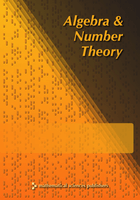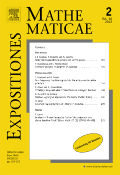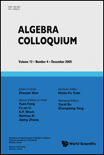
APPLIED CATEGORICAL STRUCTURES
Scope & Guideline
Connecting Scholars Through Groundbreaking Research
Introduction
Aims and Scopes
- Categorical Foundations and Structures:
The journal emphasizes research that explores the foundational aspects of category theory, including the study of various categorical structures such as monoids, functors, and limits. This foundational work is crucial for developing more complex theories and applications. - Applications in Algebra and Topology:
Many papers focus on the application of categorical methods in algebraic structures and topological spaces. This includes research on homotopy theory, algebraic topology, and other algebraic frameworks where categorical approaches yield significant insights. - Interdisciplinary Approaches:
The journal promotes interdisciplinary research that applies categorical constructs to fields beyond pure mathematics, such as computer science, physics, and engineering, showcasing the versatility of categorical theory. - Research on Functors and Natural Transformations:
A consistent focus is placed on the study of functors and natural transformations, which are central to category theory. This includes exploring their properties, relationships, and applications in various mathematical contexts. - Higher Categories and Homotopy Theory:
Emerging themes include higher category theory and homotopy theory, where researchers investigate the relationships between different types of categorical structures and their implications for mathematical theories.
Trending and Emerging
- Differential and Tangent Categories:
Research focusing on differential geometry and tangent categories is gaining traction, reflecting an increasing interest in applying categorical methods to geometric and topological problems, particularly in the context of smooth manifolds and differential bundles. - Homotopy Theory and Higher Structures:
There is a notable trend towards exploring homotopy theory and higher categorical structures, indicating a growing recognition of the significance of these areas in contemporary mathematical research and their applications in various domains. - Quantum Field Theories and Categorical Approaches:
Emerging themes include the application of categorical structures in quantum field theories, showcasing a novel intersection between physics and category theory that opens new avenues for research and applications. - Functorial Approaches to Machine Learning:
Recent papers have begun to explore the implications of categorical structures in machine learning, indicating a burgeoning interest in how category theory can inform and enhance computational methodologies. - Diagrammatic Methods and Comodules:
The use of diagrammatic methods in category theory, particularly in the context of comodule theory and monads, is increasingly prominent, signaling a shift towards more visual and intuitive approaches to categorical concepts.
Declining or Waning
- Classical Algebraic Structures:
Research related to classical algebraic structures, such as basic ring theory or elementary group theory, appears to be less frequently represented in recent issues. This may indicate a shift towards more complex and abstract structures that require categorical frameworks. - Elementary Category Theory:
There seems to be a decrease in publications focused on elementary aspects of category theory, such as basic definitions and foundational results. The journal is increasingly favoring more advanced applications and methodologies. - Traditional Topological Constructs:
Papers focusing on traditional topological constructs, such as basic metric spaces or standard topological properties, are becoming less common. This may reflect a growing interest in more sophisticated topological frameworks that utilize categorical approaches. - Monoidal Categories:
While still important, the specific study of monoidal categories has seen a reduction in frequency, suggesting that researchers may be moving towards exploring more generalized or higher structures that extend beyond classical monoidal contexts.
Similar Journals

Algebra & Number Theory
Pioneering Research in Algebra and Number TheoryAlgebra & Number Theory, published by Mathematical Science Publications, stands at the forefront of mathematical research, particularly in the fields of algebra and number theory. With an ISSN of 1937-0652 and E-ISSN 1944-7833, this esteemed journal provides a dedicated platform for the dissemination of cutting-edge theoretical advances and practical applications. It has achieved a Q1 category ranking in both algebra and number theory according to the 2023 quartiles, reinforcing its critical role in shaping contemporary mathematical discourse. The journal serves as an essential resource for researchers, professionals, and students alike, offering insights into diverse mathematical methodologies and fostering open dialogue among scholars. Although it does not provide open access, its robust impact factor reflects the high quality and relevance of its published work. Based in the United States at the University of California, Berkeley, the journal's commitment to excellence continues to attract contributions that push the boundaries of mathematical understanding.

Algebraic and Geometric Topology
Bridging Algebra and Topology for Future DiscoveriesAlgebraic and Geometric Topology, published by Geometry & Topology Publications, is a premier journal dedicated to the fields of algebraic and geometric topology. With its ISSN of 1472-2739 and a commendable Q1 ranking in 2023, this journal serves as a vital resource for top-tier research, showcasing groundbreaking developments and fostering discussions among mathematicians globally. Operating since 2007 and continuing through 2024, the journal is positioned within the United States and aims to deliver open access to the latest findings, promoting collaboration and innovation. As a significant contributor to the mathematical landscape, Algebraic and Geometric Topology appeals not only to researchers and professionals, but also to students eager to explore the rich interplay between algebra and topology, making it an essential read for anyone involved in advanced mathematical studies.

Cambridge Journal of Mathematics
Exploring Innovative Solutions in MathematicsCambridge Journal of Mathematics, published by INT PRESS BOSTON, INC, is a premier platform for the dissemination of cutting-edge research in the field of mathematics. With an ISSN of 2168-0930 and E-ISSN 2168-0949, this journal stands out in a competitive academic landscape, currently ranked #58 out of 399 in General Mathematics, placing it in the top 15% within its category according to Scopus metrics. The journal serves as a vital resource for researchers, professionals, and students alike, aiming to foster groundbreaking mathematical inquiries and foster collaboration across disciplines. Published from 2020 to 2024, the Cambridge Journal of Mathematics is committed to maintaining high standards of scholarship, making it an essential read for those who are passionate about advancing mathematical knowledge and its applications.

MICHIGAN MATHEMATICAL JOURNAL
Elevating Scholarship through Innovative Mathematical DiscoveriesThe MICHIGAN MATHEMATICAL JOURNAL is a prestigious and influential publication in the field of mathematics, founded by the University of Michigan. With an ISSN of 0026-2285 and an E-ISSN of 1945-2365, this journal is recognized for its high-quality research and has achieved a commendable Q1 ranking in the category of Mathematics (miscellaneous) as of 2023. Published by the esteemed Michigan Mathematical Journal, it provides a platform for the dissemination of innovative mathematical theories and findings, playing a crucial role in advancing knowledge and scholarship within the mathematical community. With coverage spanning from 1996 to 2024, the journal emphasizes rigorous theoretical development and fosters collaboration among researchers, professionals, and students alike. While not an open-access journal, its contributions are invaluable for those looking to stay abreast of cutting-edge mathematical research.

ARS Mathematica Contemporanea
Elevating Mathematical Discourse GloballyARS Mathematica Contemporanea, published by UP FAMNIT in Slovenia, stands as a pivotal journal within the fields of algebra, number theory, discrete mathematics, geometric topology, and theoretical computer science. Since its inception in 2011, this journal has consistently provided a rich platform for innovative research, garnering a commendable Q2 category ranking in various mathematical domains, including Algebra and Number Theory, and Geometry and Topology, showcasing its growing influence and prestige in the academic community. With an increasing Scopus rank—particularly notable in Algebra and Number Theory at the 71st percentile—ARS Mathematica Contemporanea is dedicated to publishing high-quality, peer-reviewed content that advances the frontiers of mathematical knowledge. The journal’s commitment to open access ensures that valuable research is readily available to scholars, practitioners, and students alike, fostering collaboration and dissemination of ideas across the globe. As it converges towards its dedicated timeline extending to 2024, ARS Mathematica Contemporanea remains a crucial resource for those engaged in mathematical research, presenting an array of theoretical and practical insights that define contemporary mathematical discourse.

EXPOSITIONES MATHEMATICAE
Exploring Innovative Theories in MathematicsEXPOSITIONES MATHEMATICAE, published by Elsevier GmbH, stands as a significant journal in the realm of mathematics, catering primarily to researchers, professionals, and students. With an ISSN of 0723-0869 and an E-ISSN of 1878-0792, this journal has made its mark in the academic community, boasting a Q2 classification in the miscellaneous mathematics category for 2023, illustrating its prominence within its field. The journal addresses a diverse scope of mathematical topics, encouraging the publication of original research and innovative theories while maintaining rigorous academic standards. As it converges from 2004 to 2024, EXPOSITIONES MATHEMATICAE continues to be an essential resource for advancing mathematical knowledge and fostering scholarly communication, despite being a non-open-access publication. Its location in Munich, Germany further anchors it within a rich intellectual tradition, providing accessibility for the mathematical community worldwide.

ANNALES DE L INSTITUT FOURIER
Pioneering Research in Algebra and GeometryANNALES DE L INSTITUT FOURIER is a premier academic journal published by ANNALES INST FOURIER, specializing in the fields of Algebra and Number Theory as well as Geometry and Topology. Since its establishment, the journal has garnered a distinguished reputation, evidenced by its Q1 quartile ranking in the 2023 category assessments and its Scopus Rank of #37 out of 119 in Algebra and Number Theory, and #34 out of 106 in Geometry and Topology, placing it within the top percentile of its field. The journal serves as a vital platform for disseminating groundbreaking research and innovative methodologies, catering to a global audience of researchers, professionals, and students. With a commitment to the advancement of mathematical sciences, ANNALES DE L INSTITUT FOURIER invites contributions that push the boundaries of knowledge and foster collaboration across disciplines. Although it does not offer open access, the rigorous peer-review process ensures that published papers meet the highest academic standards, making it a critical resource for anyone engaged in advanced mathematical research.

ALGEBRA COLLOQUIUM
Connecting Scholars to the Frontiers of Applied MathematicsALGEBRA COLLOQUIUM is a prominent journal dedicated to advancing the field of mathematics, specifically focusing on Algebra and Number Theory as well as Applied Mathematics. Published by World Scientific Publishing Co Pte Ltd, this journal is based in Singapore and has been a cornerstone in mathematical research since its inception in 1996, with an anticipated convergence through 2024. With an ISSN of 1005-3867 and E-ISSN of 0219-1733, it features rigorous peer-reviewed papers that cover a diverse range of topics within its scope. Reflecting its quality, Algebra Colloquium is ranked in the Q3 quartile in both Algebra and Number Theory as well as Applied Mathematics, indicating its significance amidst a competitive publication landscape. Researchers, professionals, and students looking to stay at the forefront of mathematical innovation will find a wealth of knowledge and research insights within these pages, making it an essential resource for anyone committed to deepening their understanding of algebraic concepts and techniques.

Journal of Homotopy and Related Structures
Pioneering Insights in Geometry and Number TheoryJournal of Homotopy and Related Structures is a distinguished academic journal published by Springer Heidelberg, specializing in the fields of algebra, number theory, geometry, and topology. With a focus on the intricate relationships and structures within these disciplines, the journal aims to facilitate the dissemination of original research and provide a platform for scholarly exchange among mathematicians. Since its inception in 2012, the journal has positioned itself in the Q2 category for both Algebra and Number Theory and Geometry and Topology in 2023, reflecting its growing influence and commitment to high-quality publications. Although it operates under a subscription model, the research published in this journal is highly cited, contributing to its notable rankings—#57 in Geometry and Topology and #65 in Algebra and Number Theory on the Scopus index. This journal is an essential resource for researchers, professionals, and students who wish to stay updated with the latest advancements and trends in homotopy theory and related mathematical structures.

Theory and Applications of Categories
Advancing Mathematical Understanding Through CategoriesTheory and Applications of Categories is a distinguished academic journal published by Mount Allison University in Canada, focusing on the intricate and evolving field of category theory and its diverse applications within mathematics. Since its inception in 1996, the journal has aimed to foster a comprehensive understanding of category theory through the dissemination of high-quality research and innovative findings, maintaining a strong position within the field as evidenced by its Q2 ranking in the 2023 Mathematics (miscellaneous) category. With an impact factor reflective of its relevance, this journal serves as a vital platform for researchers, professionals, and students alike, providing open access for those interested in the latest theoretical advancements and practical applications in this fascinating domain. The journal is committed to promoting collaborative research and stimulating intellectual discourse, ensuring its continued contribution to the mathematical community until at least 2024. For those seeking to expand their knowledge and engage with cutting-edge research, Theory and Applications of Categories represents an essential resource in the realm of mathematics.